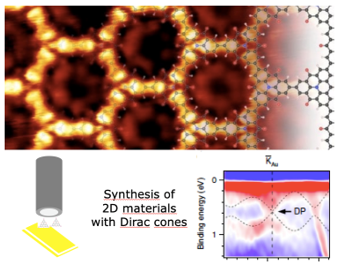Video Article Open Access
On-surface Synthesis of 2D Materials with Dirac Cones and Semiconducting Properties
Giorgio Contini1,2
1Istituto di Struttura della Materia-CNR (ISM-CNR), Via Fosso del Cavaliere 100, 00133 Roma, Italy
2Department of Physics, University Tor Vergata, Via della Ricerca Scientifica 1, 00133 Roma, Italy
Vid. Proc. Adv. Mater., Volume 2, Article ID 2105188 (2021)
DOI: 10.5185/vpoam.2021.05188
Publication Date (Web): 17 Sep 2021
Copyright © IAAM
Graphical Abstract

Abstract
The isolation of graphene and the demonstration of its remarkable charge-transport properties, due to high-mobility charge carriers coming from the Dirac cones in its band structure, have made two-dimensional (2D) materials a major trending topic in materials science and nanotechnology. Dirac cones are not exclusive to graphene but require specific symmetry and delocalized electrons. Efforts have been devoted to identifying 2D materials beyond graphene that offer a greater degree of tunability and a non-zero band gap while retaining high-mobility charge carriers [1,2].
In this respect, on-surface synthesis (OSS), a bottom-up strategy to create 2D nanomaterials with tuneable characteristics by varying the precursors molecular building blocks (e.g., by the change of constituent atoms and symmetry) [3]. Although many experimental protocols of OSS can be found in literature, the rationale relies mainly on the evaporation of these precursors on metal surface, whereas the halogen atoms are released. A final thermal annealing promotes the coupling reaction that can produce the final structures. OSS is usually coupled to in-situ surface science techniques for a comprehensive characterization of the chemical composition, atomic scale structure and morphology. OSS represents an opportunity to manipulated the electronic band structure of the material and produce 2D π-conjugated polymers.
On this Lecture I will report on the realization of a mesoscale ordered 2D π-conjugated polymers on Au(111) with semiconducting properties arranged in a kagome lattice showing Dirac cone structures and flat bands, previously predicted theoretically [4,5]. These results overcome the major barriers to the application of 2D π-conjugated polymers due small domain size and high defect density attained so far. Importantly, although the 2D polymers have been obtained on a metal surface, they can be detached and transferred to other substrates to be used in devices. I will also report on the basic idea of the on-surface synthesis tool and our studies concerning the formation of 1D and 2D polymers.
Keywords
On-surface synthesis; semiconductor 2D materials beyond graphene; dirac cone.
Acknowledgement
This work was partially supported by the project Grande Rilevanza Italy-Quebec of the Italian Ministero degli Affari Esteri e della Cooperazione Internazionale (MAECI), Direzione Generale per la Promozione del Sistema Paese.
References
- K. Asano and C. Hotta, Phys. Rev. B, 2011, 83, 245125.
- J.Wang, S. Deng, Z. Liu and Z. Liu, Natl Sci. Rev., 2015, 2, 22.
- Y. Jing and T. Heine, J. Am. Chem. Soc., 2019, 141, 743.
- G. Galeotti, F. De Marchi, E. Hamzehpoor, O. MacLean, R. M. Rao, Y. Chen, L. V. Besteiro, D. Dettmann, L. Ferrari, F. Frezza, P. M. Sheverdyaeva, R. Lui, A. K. Kundu, P. Moras, M. Ebrahimi, M.C. Gallagher, F. Rosei, D.F. Perepichka, G. Contini, Nature Materials, 2020, 19, 874.
- Sandro Iannnaccone, La Repubblica, 2020
Biography
Giorgio Contini got a MSc in Physics from La Sapienza University, Roma, Italy and a PhD in Materials for Health, Environment and Energy from Tor Vergata University, Roma, Italy. He is Researcher and Laboratory Head at the Istituto di Struttura della Materia (ISM), National Research Council (CNR) and Acting Professor at the Physics Department, Tor Vergata University, Roma, Italy. Its main research activity concern two-dimensional nanostructured materials mainly based on molecular self-assembly and reactivity on surfaces. The principal aim is to develop organic molecular structures on surfaces that are of particular importance for molecular electronic devices, sensors and catalysis.
He is organizer of Conferences/seminars and International School Teacher, and Invited speaker at International Congress. Member of American Chemical Society (ACS), Italian Physical Society (SIF) and Italian Society of Synchrotron Light (SILS). He is/was Professor at Universities: Professor for the courses Laboratory of Experimental Physics 2 and Organic molecules on surfaces, Assistant Professor for the course Microscopy and Nanoscopy and Laboratory of Physics of Materials, Physics department, Tor Vergata University, Roma, Italy; Professor Maitre des Conference and Professor in the ERASMUS+ program at the Physics department, Université de Lorraine, Nancy, France; Assistant Professor for the course Modern Applied Physics, Physics department, Tor Vergata University, Roma, Italy; Assistant professor for the course Inorganic Chemistry, Chemistry Department, Sapienza University, Roma, Italy. Students and Postdoc supervisor from 2002: 3 Post-doc, 3 PhD students, 7 Master students, 7 Bachelor students, 2 Master degree Intership.
Video Proceedings of Advanced Materials

Upcoming Congress



